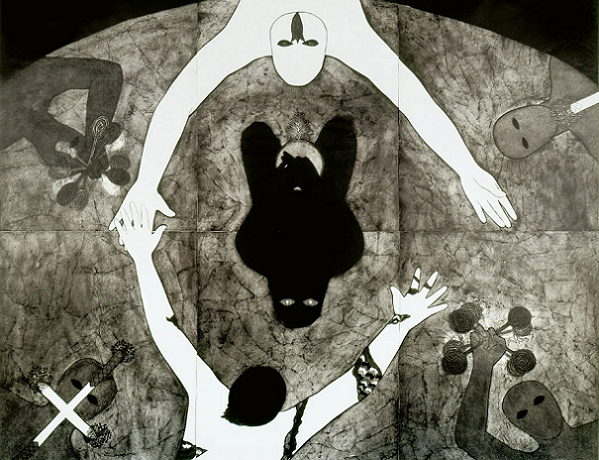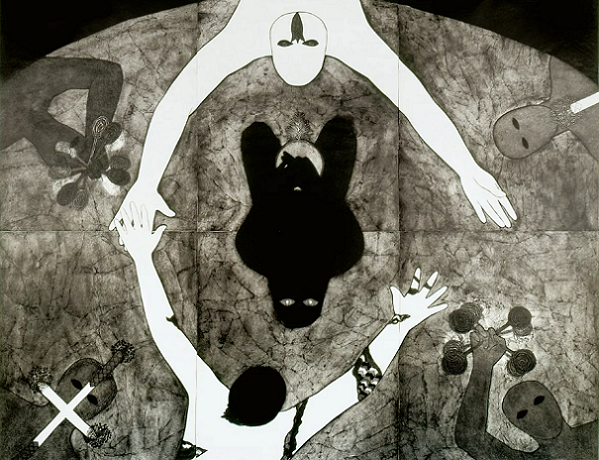
[Many thanks to Veerle Poupeye (Critical.Caribbean.Art) for bringing this item to our attention.] Carolina Ana Drake (ARTnet) reviews the amazing work and trajectory of Belkis Ayón, whose work is the subject of an exhibition (through April 25) at Miami gallery David Castillo.
In the decade before her death, in 1999 at age 32, artist Belkis Ayón stumbled upon the mythological story of Sikán in a book about Abakuá, a secret Afro-Cuban fraternal organization exclusive to men. At the time, she had been painting with vivid colors, but as she delved deeper into the story of Sikán, her palette would shift to blacks and whites, with an emphasis on light and shadow. “Sikán is the woman sacrificed by men in an attempt to obtain her sacred voice,” Ayón once said in a 1993 interview.
It is these Sikán-related works that would garner acclaim for Ayón, who was born in Havana in 1967. Her art would be included in the 1993 Venice Biennale, the 1994 Havana Biennial, and the 1997 Gwangju Biennale. More recently, her 2016 retrospective would travel to five US cities, including Los Angeles, New York, and Houston, as well as the 2022 Venice Biennale, surrounding a sculpture by Simone Leigh. And now, it is the subject of an exhibition (through April 25) at Miami gallery David Castillo, the artist’s first commercial showing since her death 25 years ago.
At the gallery, each work is a door into the artist’s imagination. Organized chronologically and presenting pieces made between 1989 to 1999, the exhibition begins with Ayón’s first representation of Sikán in Sálvanos Abasi (Abasi Save Us), from 1989, where a genderless figure with dark, fathomless eyes, no mouth, and a small sacred fish hanging from her necklace stares intensely back at the viewer. In the myth, Sikán, a princess, accidentally catches a sacred fish, considered the reincarnation of a king, that jumps into her bucket while she fetches water from a nearby river. This fish contained the secret voice that would lead whoever cares for it to prosperity. When the Abakuá men learn of this, they send serpents to scare Sikán and then sacrifice her, believing the fish’s secret voice to have entered Sikán’s skin.
Ayón continues with her own version of this story, looking for openings and closures in the myth. In 1993’s Vamos (Let’s Go), a genderless figure that appears to be Sikán has fish scales now encrusted on their body as they present the sacred fish to the other phantasmagoric figures. In Siempre Vuelvo (I Always Return), also from 1993, Sikán is depicted as risen and resurrected into a dark cosmos. Her mouth remains covered, her hands crossed. Beneath her spirit, three bodies appear to be those that sacrificed her, gesturing upward.
But, Ayón didn’t simply want to reproduce this myth. “My goal is to synthesize the aesthetic, visual, and poetic details that I find in the Abakuá mythology and to add my vision,” she said in a 1999 interview [. . .].
Ernesto Leyva, Belkis Ayón’s uncle and the director of the Belkis Ayón Estate, recently recalled how difficult this decade, also called El Período Especial (the Special Period), was for Cuba and its artists. Electricity was rationed and blackouts were frequent, meaning Ayón likely created her world of myth and mysteries in candlelight or near darkness. Similarly, whenever Ayón traveled outside Cuba, she returned with art materials for her students, as materials were nearly impossible to find on the island. [. . .]
Cuban art historian and curator Cristina Vives, who was friends with Ayón, has argued that understanding Ayón’s work is incomplete without fully comprehending the historical context that Ayón lived through. “We experienced the ’90s decade in Cuba together, a hard time politically and economically, but also the time of a huge art boom in Cuban art among the generation to which Belkis belonged,” Vives said during a 2023 talk about Ayón at the Ludwig Forum Aachen in Germany, , which mounted a 70-work survey of the artist in 2022.
During the Periódo Especial, censorship was also on the rise, affecting artists, activists, and anyone who questioned the government’s dogmatic policies. Despite this political climate, and likely because of it, Cuba’s art scene flourished, with artists like Juan Francisco Elso, Lázaro Saavedra, Tania Bruguera, and Tomás Esson, whose 1986 exhibition in Havana was famously censored for its political commentary, making work alongside Ayón. “People would flood the art galleries in Cuba looking for truth,” Vives recalled in her 2023 talk.
And it is within this context that Ayón’s series related to the secret society of Abakuá emerged. Perhaps, that covertness appealed to the artist as a refuge, one in which she was free to create. “Those eyes look at you very directly,” Ayón said in a 1999 interview, speaking about the figures she depicted. “So you cannot hide: wherever you move, they are always looking at you…”
Dealer David Castillo knew he was standing before something powerful when he first saw Ayon’s work almost 10 years ago. His connection to her work deepened as he learned more about her work and her influence, not only to her students but generations of artists who have come-up since her passing. “She was never an overlooked artist. This show is just a continuation of her career when she was alive,” Castillo said. [. . .]
In showing works at a commercial gallery that are not for sale, Castillo said, “This is about promoting the artist’s legacy and continuing the work we have done with the estate during these years.” [. . .]
For full article, see https://www.artnews.com/art-news/artists/belkis-ayon-david-castillo-gallery-exhibition-miami-1234699917/
[Shown above, photo by SEBASTIAAN HANEKROOT/COURTESY BELKIS AYÓN ESTATE AND DAVID CASTILLO: Belkis Ayón, “Ya estamos aquí” (We Are Here), 1991; Belkis Ayón, “Vamos” (Let‘s Go), 1993.]
[Many thanks to Veerle Poupeye (Critical.Caribbean.Art) for bringing this item to our attention.] Carolina Ana Drake (ARTnet) reviews the amazing work and trajectory of Belkis Ayón, whose work is the subject of an exhibition (through April 25) at Miami gallery David Castillo. In the decade before her death, in 1999 at age 32, artist Belkis Ayón stumbled








